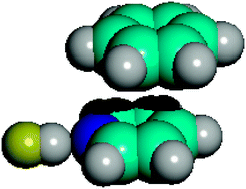Cooperativity of π-stacking and hydrogen bonding interactions and substituent effects on X-ben‖pyr⋯H–F complexes
Abstract
Quantum chemical calculations have been performed to gauge the effect of π-stacking and hydrogen bonding interactions on each other in X-ben‖pyr⋯H–F (X = NO2, CF3, CN, F, Cl, CH3 and OH) complexes. The results indicate the cooperativity of interactions in these complexes where face-to-face aromatic interactions and hydrogen bonding interactions coexist. The effects of substituents on the X-ben‖pyr⋯H–F complexes have also been studied with the MP2 method using 6-31G** basis set. The total binding energy increases in both electron-donating and withdrawing substituents. Herein, computational results indicate an enhanced π-stacking interaction for all substituted complexes related to an unsubstituted case. On the other hand, H⋯N hydrogen bond interaction is declined by strong electron withdrawing substituents (NO2 and CN) only. The cooperativity of π-stacking and H⋯N hydrogen bond interaction has also been studied by using the atoms in molecules (AIM), natural bond orbital (NBO) and molecular electrostatic potential (MEP) analyses. There are good relationships between the Hammett constants and energy data, geometrical parameters, and the results of population analysis in X-ben‖pyr⋯H–F and X-ben‖pyr complexes. The characteristics of interactions are directly related to the electrostatic interaction between the rings.


 Please wait while we load your content...
Please wait while we load your content...